|
Artifact Suite (1984 and 2004)
Artifact Suite is a revised version of an evening-length piece from 1984 (Artifact), the time when choreographer William Forsythe entered the world stage as the artistic director of the Frankfurt Ballet. 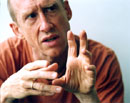 Coming from the Joffrey Ballet, he had been engaged as a dancer and then Resident Choreographer of the Stuttgart Ballet. Twenty years after Artifact, Artifact Suite appears as a signature piece of Forsythe establishing his claim to the heritage of Balanchine, the great master of dance making. Coming from the Joffrey Ballet, he had been engaged as a dancer and then Resident Choreographer of the Stuttgart Ballet. Twenty years after Artifact, Artifact Suite appears as a signature piece of Forsythe establishing his claim to the heritage of Balanchine, the great master of dance making.
The San Francisco opera stage is a black box, filled with dancers and filled with a gloomy whitish light that hits the bodies vertically from above and highlights every muscle, shoulder, neck, arms. Artifact Suite is a ballet about arms, arms and legs, the main tools of dance. The mass of dancers is lined up in a strict square around the black room, all in pale saffron-colored leotards, the women with half transparent black tights pulled over the leotards. The tights again heighten muscle in every place where muscle bulges through them, creating a sexy athletic look (design and lighting by Forsythe). To music by Bach, two couples are engaged in fierce asymmetrical pas de deux in the center, while a single woman, at stage front, her back to the audience, sends out arm signals some of which the group picks up and repeats. At times the group sets into motion forming advancing or receding lines across the stage. Their arm signals seem to guide some unidentified flying objects onto an imaginary airstrip: right-left, up-down, straight-slanted. This intriguing "runway" could just as well be the "runspace" of a ballet studio with its lined-up bars and strict order of geometry in motion. In counterpoint, the two couples are doing twists and turns of highly aggressive acrobatics that seem inspired by combat moves and ice skating – the way the male partner twists and knots the female body around his own or shoves her into the air. I almost expected the women to fly off in a triple Lutz and land in an arabesque somewhere down the stage.
The pas de deux are danced at maximum speed, faster than any Balanchine speed, with higher and more extreme extensions and off-balances. At seemingly arbitrary points, the fire curtain falls with a loud thump. The house is plunged into darkness, the music goes on without the dancers. The curtain lifts again: a new placement of the dancers opens a new chapter of the story and the combat continues unabated. The shock effect of the loud jump-cut of the curtain seems whimsical – now you see them, now you don't – and at the same time well calculated. Forsythe is always interested in disturbing the audience's habits of seeing without seeing. Like an effective movie cut, the curtain crush adds to the excitement of what is shown.
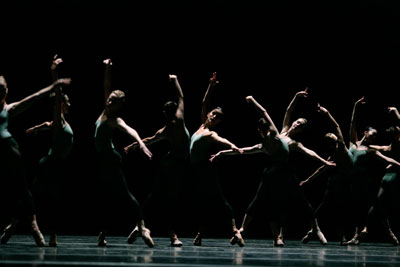
San Francisco Ballet in Forsythe's Artifact Suite © Erik Tomasson
After a break, the music (in part played on a live piano) is by modern composer Eva Crossman-Hecht. The couples have disappeared. The mood of the ballet studio as metaphor for the world is heightened. In a fascinating passage (named "Hypno"), all the women, now in dust-blue leotards, do hundreds of fast tendus – the most simple and basic ballet move where one leg slides out from the fifth position to the front or side or back and slides back. At any time, the other leg takes over to do the same. This is accompanied by the coded arm movements of classical dance and the épaulements (developed by 19th century choreographer Bournonville), shoulder turns toward the diagonal that break up the severe right angle and add a considerable element of spice. To Balanchine, the tendu was the simple cornerstone of ballet and the hardest movement of its repertoire. He had his dancers train tendus for years on end, and any technical problem they complained about was answered by the master's "Don't worry, dear, just keep working your tendus." Forsythe seems to have taken this knowledge and manically filled a whole stage, a whole chapter of this choreography with its mysteries. The music is mournful, like a piece of Arvo Pärt, and the air is packed with the silky rustling of the thousand hypnotic tendus, all happening in syncopated different directions and timings.
Then the men come in to a more Stravinsky-toned set of music and get their own chapter of thumping, more athletic syncopated movement to a strong beat. They pick up the theme of ballet arm positions – a lifting, opening, stretching, closing… and starting over with a clap. Finally, the entire group unites in an almost frenetic pace of arm lifts, rotations, whirls. The madly spinning wheel of movement through space seems to be anchored by the single woman who again gives her signals and sometimes passes more elaborate movements to the others. Perhaps she stands in for the ballet master or puppet master of this dizzying universe of body control through geometry and extreme exertion that is William Forsythe's classical ballet.
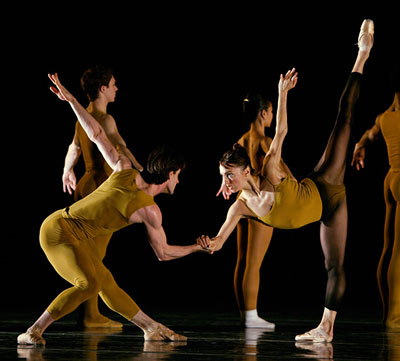
Lorena Feijoo and Pascal Molat in Forsythe's Artifact Suite © Erik Tomasson
Every one of the 36 SF Ballet dancers looked perfect in this design and style of movement. However, there were two bodies that seemed to crystallize Forsythe's intention of pushing the boundaries of the habitual or expected. Elana Altman was the signal woman, outstanding through the star-like beauty of her body proportions and movements. She has a body like Susanne Farrell, Balanchine's greatest muse, and apparently she also has potential: she was recently made a soloist and cast in Balanchine's masterpiece Apollon Musagete. I did not see her in Apollon, but here, she dominated the group with her simple presence and few, but gorgeous movements. Unfortunately I also missed the virtuosic Lorena Feijoo in one of the combat couples, but I saw SF Ballet's soon-to-retire prima ballerina Muriel Maffre (well partnered by Jean François Vilanoba). At the astonishing age of 41, Muriel Maffre was the embodiment of everything strange and thrilling in this choreography. Her tallness, small head with its feathery short hair, her long, wing-like limbs, her effortless extreme extensions and tense energy, together with her usual somewhat mournful grace, created the effect of an alien creature. Neither woman nor man, this kind of creature seemed set to inhabit the future – the future of dance après Balanchine.
Three Atmospheric Studies
A lot of anticipation, with previews the length of a whole page in the NY Times, has greeted Forsythe's latest piece, Three Atmospheric Studies, at its U.S. opening at Cal Performances in Berkeley. Recently premiered in London, this is Forsythe's first choreography for his new company since Frankfurt politics closed down his famous Frankfurt Ballet where the choreographer had made headlines for twenty years, from 1984 to 2004. The Forsythe Company consists of a dozen and a half dancers from all over the globe (but none, as it happens, from Germany). The excitement reflects two things: the importance of 57-year-old Forsythe who is considered (at least by ballettomanes in Europe) the foremost choreographer of our time; and the surprise of seeing Forsythe turn to an outspoken political stance that brings up associations of "agit-prop". Three Atmospheric Studies is a gritty, punch-in-the-belly dance theater piece on the war in Iraq. Part of the buzz is about an American who clearly and loudly expresses his shock and revulsion about this war in a piece of dance. Forsythe has done many political dance theater pieces during his Frankfurt residence, but perhaps not with such blunt personal engagement and honesty. And he has certainly not talked about the politics of his home country, literally hitting home.
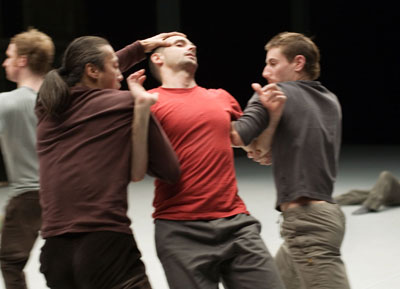
Sang Jijia, Ander Zabala, and Ioannis Mantafounis (f,l,r) Cal Performances 2007.Photo- Dominik Mentzos
Three Atmospheric Studies is based on iconic images: an early 16th century painting of the crucifixion (by Lucas Cranach the Elder) with Mary lamenting under the cross, and a Reuters photo of an Iraqi street scene with an explosion in the background and solders running, carrying a wounded body between them.
The "Tryptich" begins with the annunciation of the theme by a woman in a tight pink dress (Jone San Martin). "My son was arrested," she declares with a thick foreign accent. The stage is once again a black box lit from above by four projector lamps in the shape of a cross. In repetitive stop-start fashion, a good dozen dancers in simple cotton street clothes run, punch, roll, flee, grab, hold down, kick each other in a way that instantly evokes the scene of an arrest amidst the chaos of a crowd. The arrest is played backwards, forwards in fast variations, forcing everyone in turn into the role of victim, persecutor, bystander, witness. The only accompanying sound is silence and the shuffle and stomping of feet, hissing breath, the different slaps of bodies hitting other bodies or hitting the floor.
The connection with Mary, the mother in the painting, is instant: she is, in Forsythe's words, "a mother in the Middle East staring at the body of her dead son who's just been executed by local authorities under the supervision of an occupying force." The group precision based on body rhythms is impressive, and there are moments of spiritual intensity when the dancers freeze with their faces raised, as if in a vision. Are they staring at the crucifixion of Christ or at some other apparition of God or death coming out of the sky? Such moments are Forsythe perspectives par excellence: it is unclear what exactly we are being shown, but it is intriguing and we are challenged to see with our own eyes.
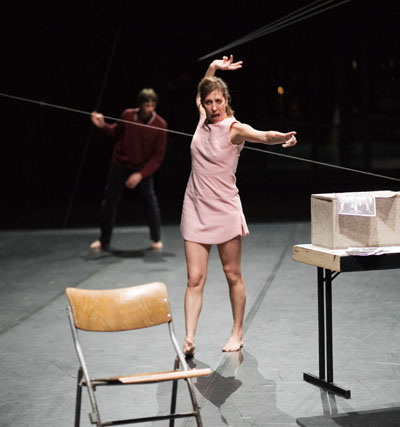
Jone San Martin Cal Performances 2007.Photo- Dominik Mentzos
In the second part, the mother in pink tries to explain to some official person behind a desk what happened, which he translates into Arabic language, which becomes a classic dialogue de sourds: there is no shared meaning to the words. A third person, a man, interrupts. He talks to the audience while he pulls plastic lines across the black stage and fixes their long diagonals to the floor and walls with a hand drill. As in an absurdist commentary, he lectures about perspectives, referring to the Cranach painting and other images of violence. It transpires that depending on the perspective, the scene of violence (the arrest) is open to any interpretation. Nothing is clarified, but somehow the son is dead. The confusion of the mother spirals out of control in a microphone-distorted monologue of protest and pain, physically expressed with body contortions that allude to insanity.
The last part of the Tryptich sums up the first two. We now see a new version of the arrest scene, this time with the full-blown force of microphone-distorted sound frequencies, screams, repeated explosions that throw everyone to the ground, machine gun splutter and the thundering of bodies smashed against the press-wood walls of what might be a barracks office. The "art interpreter" turns into something between a war reporter and an archeologist of death ("Here's a finger with a ring still in it, here's a skull, a femur bone…") while an American commander delivers the party-line of the occupying forces. He is played by Forsythe's wife, Dana Caspersen, whose voice is chillingly distorted into the voice of a man (à la Laurie Anderson). S/he lectures the mother who is now reduced to silent stupor while the explosions are raging on around her. "This is not personal, Ma'am," the commander assures her and all Irakis, in a cool, suave tone. "Everything that happened is because we planned it. We are offering you structure, Ma'am. What we need is what we give you, and we give you what you need." The effect of this familiar military/political hogwash is reflected in the silent figure of a dancer standing alone, isolated, during the entire scene, twisting her body into poses of the mentally insane. It ends with a Pina Bausch moment when an interpreter or middleman shoves and manipulates the almost lifeless body of the mother into a semblance of a walk, a Calvary walk, before laying her down to (her final?) rest.
The new piece could not be further away from the erotic ballet-studio beauty and futuristic abstraction of Artifact Suite, but a lot of the movement language is well-known Forsythe. It's a powerful, effective piece of work, perfectly staged and performed (with texts by Forsythe, Dana Casperson and David Kern). In the form and mood of the piece I saw a striking déjà vu of improv theater, political theater and dance theater of the sixties and seventies, starting with the Living Theater. The piece also made me think of Richard Foreman's work with perspectives and lines of vision literally drawn through the theater space. From a larger perspective, Three Atmospheric Studies is not as "new" it seems. Nevertheless, it pulls a powerful punch when a great choreographer's work is politically up to date.
Cover Image: Muriel Maffre and Pierre-François Vilanoba
in Forsythe's Artifact Suite © Erik Tomasson
|
